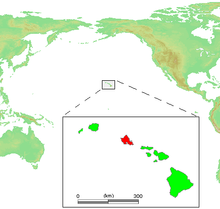This is the current revision of this page, as edited by Citation bot (talk | contribs) at 05:05, 30 December 2024 (Altered date. | Use this bot. Report bugs. | Suggested by Jay8g | Category:CS1 maint: date format | #UCB_Category 3/6). The present address (URL) is a permanent link to this version.
Revision as of 05:05, 30 December 2024 by Citation bot (talk | contribs) (Altered date. | Use this bot. Report bugs. | Suggested by Jay8g | Category:CS1 maint: date format | #UCB_Category 3/6)(diff) ← Previous revision | Latest revision (diff) | Newer revision → (diff) Species of gastropod
| Amastra tristis | |
|---|---|

| |
| Shell of Amastra tristis (specimen at MNHN, Paris) | |
| Scientific classification | |
| Domain: | Eukaryota |
| Kingdom: | Animalia |
| Phylum: | Mollusca |
| Class: | Gastropoda |
| Order: | Stylommatophora |
| Family: | Amastridae |
| Genus: | Amastra |
| Species: | A. tristis |
| Binomial name | |
| Amastra tristis (Quoy & Gaimard, 1825) | |

| |
| Location of Oʻahu | |
| Synonyms | |
| |
Amastra tristis is a species of air-breathing land snail, a terrestrial pulmonate gastropod mollusc in the family Amastridae.
Description
The length of the shell can reach 18 mm, its diameter 11 mm
The shell is imperforate or slightly rimate, oblong-conic, and moderately solid. The coloration transitions from blackish-purple on the initial 2–3 whorls to reddish-brown with a pale sutural margin, ultimately fading to light reddish-brown or nearly white on the final whorl. The last 2–3 whorls are coated with a thin, dark brown cuticle, which is often shed in angular fragments or patches and is typically absent near the aperture.
The spire is slightly convexly conic and tapers to an acute apex, comprising 5½–5¾ nearly flat whorls. The first whorl is almost smooth, with the second adorned by regular radial ripples. Subsequent whorls exhibit fine growth striae, while the last two whorls display coarse growth wrinkles and fine spiral striae. The body whorl often features several irregularly spaced spiral grooves.
The aperture is ovate and slightly oblique, lined with a distinct internal rib within the peristome. The columella is short and moderately expanded, bearing a pronounced, spiral lamella. A thin, transparent parietal callus subtly overlays the inner surface. The shell's axis is slender and sinuous, widening slightly with each whorl, and the lamella penetrates nearly a full whorl into the structure.
The shape of the embryonic whorls and the maculation of the neanic whorls in many individuals resemble those of Amastra badia. The incised spiral striae are also characteristic of Amastra undata, Amastra transversalis, and others in the group to which A. badia belongs. This suggests that A. tristis represents a somewhat generalized or synthetic species within this assemblage.
Distribution
This species is endemic to Hawai, occurring on Oʻahu.
References
- Amastra tristis (Quoy & Gaimard, 1825). 29 December 2024. Retrieved through: World Register of Marine Species.
- Hyatt, A. & Pilsbry, H. A. (1910–1911). Manual of conchology, structural and systematic, with illustrations of the species. Ser. 2, Pulmonata. Vol. 21: Achatinellidae (Amastrinae). Philadelphia: Conchological Department, Academy of Natural Sciences. p. 205. Retrieved 3 December 2024.
{{cite book}}: CS1 maint: multiple names: authors list (link) This article incorporates text from this source, which is in the public domain.
This article incorporates text from this source, which is in the public domain.
- Cowie, R. H., Evenhuis, N. L. & Christensen, C. C. ( (1995). Catalog of the native land and freshwater molluscs of the Hawaiian Islands. vi. Leiden: Backhuys Publishers. pp. 1–248.
{{cite book}}: CS1 maint: multiple names: authors list (link)
External links
- Quoy, J.R.C. & J.P. Gaimard. (1824–1826). Zoologie. In: L. de Freycinet (ed.), Voyage au tour du monde fait par ordre du roi, sur les corvettes de S. M: l'Uranie et la Physicienne pendant les années 1817 à 1820. iv. pp. 1–712.
- Gould, A.A. (1847). "Descriptions of the following Expedition shells of the genera Achatinella and Helicina". Proceedings of the Boston Society of Natural History. 2: 200.
| Taxon identifiers | |
|---|---|
| Amastra tristis | |